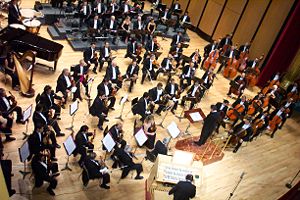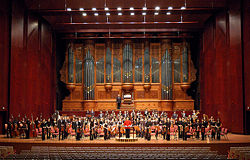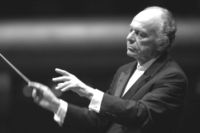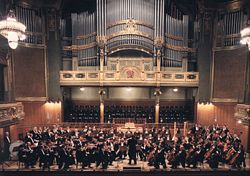Orchestra
2008/9 Schools Wikipedia Selection. Related subjects: Musical Instruments
An orchestra is an instrumental ensemble, usually fairly large with string, brass, woodwind sections, and possibly a percussion section as well. The term orchestra derives from the name for the area in front of an ancient Greek stage reserved for the Greek chorus. The orchestra grew by accretion throughout the eighteenth and nineteenth centuries, but changed very little in composition during the course of the twentieth century.
A smaller orchestra (of about forty players or less) is called a chamber orchestra.
A full size orchestra (about 100 players) may sometimes be called a "symphony orchestra" or "philharmonic orchestra"; these prefixes do not necessarily indicate any strict difference in either the instrumental constitution or role of the orchestra, but can be useful to distinguish different ensembles based in the same city (for instance, the London Symphony Orchestra and the London Philharmonic Orchestra). A symphony orchestra will usually have over eighty musicians on its roster, in some cases over a hundred, but the actual number of musicians employed in a particular performance may vary according to the work being played and the size of the venue. A leading chamber orchestra might employ as many as fifty musicians; some are much smaller than that.
Instrumentation
The typical symphony orchestra consists of four proportionate groups of similar musical instruments, generally appearing in the musical score in the following order:
- Woodwinds: piccolo, 2 flutes, 2 oboes, English horn, 2 clarinets, bass clarinet, 2 bassoons, contrabassoon (double bassoon)
- Brass: 2 to 8 horns, 2 to 5 trumpets, 3 or 4 trombones, tuba
- Percussion: timpani, snare drum, tenor drum, bass drum, cymbals, triangle, wood block, tambourine, marimba, xylophone, glockenspiel, gong (tam-tam), tubular bells, etc.
- Strings: harp(s), 16 to 30 violins, 8 to 12 violas, 8 to 12 violoncellos (cellos), and 5 to 8 double basses.
Instruments marked in boldface are considered the "core" symphonic instruments, and only in rarest of cases are not called for in most symphonic literature. Other instruments listed above are considered auxiliary instruments and are less frequently required, but still referred to as standard. Late 19th century symphonic works calling for all the auxiliary instruments, as well as an augmented number of strings, usually include the phrase "for large orchestra" in their full titles.
Beethoven’s influence
The so-called "standard complement" of double winds and brass in the orchestra from the first half of the 19th century is generally attributed to the forces called for by Beethoven. The exceptions to this are his Fourth Symphony and Violin Concerto, which each specify a single flute.
Expanded instrumentation
Apart from the core orchestral complement, various other instruments are called for occasionally. These include the saxophone, heckelphone, flugelhorn, cornet, harpsichord, and organ. Saxophones, for example, appear in a limited range of 19th and 20th century scores. While appearing only as featured solo instruments in some works, for example Ravel's orchestration of Mussorgsky's Pictures at an Exhibition, Rachmaninoff's Symphonic Dances, the saxophone is included in other works, such as Ravel's Bolero and Walton's Belshazzar's Feast, as a member of the orchestral ensemble. The euphonium is featured in a few late Romantic and 20th century works, usually playing parts marked "tenor tuba", including Holst's The Planets, and Richard Strauss's Ein Heldenleben. Cornets appear in Tchaikovsky's ballet Swan Lake, Debussy's La Mer, and several orchestral works by Hector Berlioz. Unless these instruments are played by members doubling on another instrument (for example, a trombone player changing to euphonium for a certain passage), orchestras will use freelance musicians to augment their regular rosters.
Organization
Among the instrument groups and within each group of instruments, there is a generally accepted hierarchy. Every instrumental group (or section) has a principal who is generally responsible for leading the group and playing orchestral solos. The violins are divided into two groups, first violin and second violin, each with its principal. The principal first violin is called the concertmaster (or "leader" in the UK) and is considered the leader of not only the string section, but of the entire orchestra, subordinate only to the conductor.
The principal trombone is considered the leader of the low brass section, while the principal trumpet is generally considered the leader of the entire brass section. Similarly, the principal oboe is considered the leader of the woodwind section, and is the player to whom all others tune. The horn, while technically a brass instrument, often acts in the role of both woodwind and brass. Most sections also have an assistant principal (or co-principal or associate principal), or in the case of the first violins, an assistant concertmaster, who often plays a tutti part in addition to replacing the principal in his or her absence.
A section string player plays unison with the rest of the section, except in the case of divided (divisi) parts, where upper and lower parts in the music are often assigned to "outside" (nearer the audience) and "inside" seated players. Where a solo part is called for in a string section, for example in the violins, the section leader invariably plays that part. Tutti wind and brass players generally play a unique but non-solo part. Section percussionists play parts assigned to them by the principal percussionist.
In modern times, the musicians are usually directed by a conductor, although early orchestras did not have one, using instead the concertmaster or the harpsichordist playing the continuo for this role. Some modern orchestras also do without conductors, particularly smaller orchestras and those specialising in historically accurate performances of baroque music and earlier.
The most frequently performed repertoire for a symphony orchestra is Western classical music or opera. However, orchestras are sometimes used in popular music, and are used extensively in film music.
History of the orchestra
Early history
In the 15th and 16th centuries in Italy the households of nobles had musicians to provide music for dancing and the court, however with the emergence of the theatre, particularly opera, in the early 17th century, music was increasingly written for groups of players in combination: which is the origin of orchestral playing. Opera originated in Italy, and Germany eagerly followed. Dresden, Munich and Hamburg successively built opera houses. At the end of the 17th century opera flourished in England under Henry Purcell, and in France under Lully, who with the collaboration of Molière also greatly raised the status of the entertainments known as ballets, interspersed with instrumental and vocal music.
In the 17th century and early 18th century, instrumental groups were taken from all of the available talent. A composer such as Johann Sebastian Bach had control over almost all of the musical resources of a town, whereas Handel would hire the best musicians available. This placed a premium on being able to rewrite music for whichever singers or musicians were best suited for a performance—Handel produced different versions of the Messiah oratorio almost every year.
As nobility began to build retreats away from towns, they began to hire musicians to form permanent ensembles. Composers such as the young Joseph Haydn would then have a fixed body of instrumentalists to work with. At the same time, travelling virtuoso performers would write concerti that showed off their skills, and they would travel from town to town, arranging concerts along the way. The aristocratic orchestras worked together over long periods, making it possible for ensemble playing to improve with practice.
Mannheim School
This change, from civic music making where the composer had some degree of time or control, to smaller court music making and one-off performance, placed a premium on music that was easy to learn, often with little or no rehearsal. The results were changes in musical style and emphasis on new techniques. Mannheim had one of the most famous orchestras of that time, where notated dynamics and phrasing, previously quite rare, became standard (see Mannheim school). It also attended a change in musical style from the complex counterpoint of the baroque period, to an emphasis on clear melody, homophonic textures, short phrases, and frequent cadences: a style that would later be defined as classical.
Throughout the late 18th century composers would continue to have to assemble musicians for a performance, often called an "Academy", which would, naturally, feature their own compositions. In 1781, however, the Leipzig Gewandhaus Orchestra was organized from the merchants concert society, and it began a trend towards the formation of civic orchestras that would accelerate into the 19th century. In 1815, Boston's Handel and Haydn Society was founded, in 1842 the New York Philharmonic and the Vienna Philharmonic were formed, and in 1858, the Hallé Orchestra was formed in Manchester. There had long been standing bodies of musicians around operas, but not for concert music: this situation changed in the early 19th century as part of the increasing emphasis in the composition of symphonies and other purely instrumental forms. This was encouraged by composer critics such as E.T.A. Hoffmann who declared that instrumental music was the "purest form" of music. The creation of standing orchestras also resulted in a professional framework where musicians could rehearse and perform the same works repeatedly, leading to the concept of a repertoire in instrumental music.
Performance standards
In the 1830s, conductor François Antoine Habeneck, began rehearsing a selected group of musicians in order to perform the symphonies of Beethoven, which had not been heard of in their entirety in Paris. He developed techniques of rehearsing the strings separately, notating specifics of performance, and other techniques of cuing entrances that were spread across Europe. His rival and friend Hector Berlioz would adopt many of these innovations in his touring of Europe.
Instrumental craftsmanship
The invention of the piston and rotary valve by Stolzel and Bluhmel, both Silesians, in 1815, was the first in a series of innovations, including the development of modern keywork for the flute by Theobald Boehm and the innovations of Adolphe Sax in the woodwinds. These advances would lead Hector Berlioz to write a landmark book on instrumentation, which was the first systematic treatise on the use of instrumental sound as an expressive element of music.
The effect of the invention of valves for the brass was felt almost immediately: instrument-makers throughout Europe strove together to foster the use of these newly refined instruments and continuing their perfection; and the orchestra was before long enriched by a new family of valved instruments, variously known as tubas, or euphoniums and bombardons, having a chromatic scale and a full sonorous tone of great beauty and immense volume, forming a magnificent bass. This also made possible a more uniform playing of notes or intonation, which would lead to a more and more "smooth" orchestral sound that would peak in the 1950s with Eugene Ormandy and The Philadelphia Orchestra and the conducting of Herbert von Karajan with The Berlin Philharmonic.
During this transition period, which gradually eased the performance of more demanding "natural" brass writing, many composers (notably Wagner and Berlioz) still notated brass parts for the older "natural" instruments. This practice made it possible for players still using natural horns, for instance, to perform from the same parts as those now playing valved instruments. However, over time, use of the valved instruments became standard, indeed universal, until the revival of older instruments in the contemporary movement towards authentic performance (sometimes known as "historically informed performance").
At the time of the invention of the valved brass, the pit orchestra of most operetta composers seems to have been modest. An example is Sullivan's use of two flutes, one oboe, two clarinets, one bassoon, two horns, two cornets (a piston), two trombones, drums and strings.
During this time of invention, winds and brass were expanded, and had an increasingly easy time playing in tune with each other: particularly the ability for composers to score for large masses of wind and brass that previously had been impractical. Works such as the Requiem of Hector Berlioz would have been impossible to perform just a few decades earlier, with its demanding writing for twenty woodwinds, as well as four gigantic brass ensembles each including around four trumpets, four trombones, and two tubas.
Wagner’s influence
The next major expansion of symphonic practice came from Wagner's Bayreuth orchestra, founded to accompany his musical dramas. Wagner’s works for the stage were scored with unprecedented scope and complexity: indeed, his score to Das Rheingold calls for no less than six harps. Thus, Wagner envisioned an ever-more-demanding role for the conductor of the theatre orchestra, as he elaborated in his influential work "On Conducting". This brought about a revolution in orchestral composition, and set the style for orchestral performance for the next eighty years. Wagner's theories re-examined the importance of tempo, dynamics, bowing of string instruments and the role of principals in the orchestra. Conductors who studied his methods would go on to be influential themselves.
20th century orchestra
As the early 20th century dawned, symphony orchestras were larger, better funded, and better trained than ever before; consequently, composers could compose larger and more ambitious works. With the recording era beginning, the standard of performance reached a pinnacle. In recordings, small errors in a performance could be "fixed," but many older conductors and composers could remember a time when simply "getting through" the music as best as possible was the standard. Combined with the wider audience made possible by recording, this led to a renewed focus on particular conductors and on a high standard of orchestral execution. As sound was added to silent film, the virtuoso orchestra became a key component of the establishment of motion pictures as mass-market entertainment.
Counter-revolution
In the 1920s and 1930s, economic as well as artistic considerations led to the formation of smaller concert societies, particularly those dedicated to the performance of music of the avant-garde, including Igor Stravinsky and Arnold Schoenberg. This tendency to start festival orchestras or dedicated groups would also be pursued in the creation of summer musical festivals, and orchestras for the performance of smaller works. Among the most influential of these was the Academy of St. Martin in the Fields under the baton of Sir Neville Marriner.
With the advent of the early music movement, orchestras where players worked on execution of works in styles derived from the study of older treatises on playing became common. These include the London Classical Players under the direction of Sir Roger Norrington and the Academy of Ancient Music under Christopher Hogwood, among others.
Recent trends
The late 20th century saw a crisis of funding and support for orchestras in Europe. The size and cost of a symphony orchestra, compared to the size of the base of supporters, became an issue that struck at the core of the institution. The drastic falling-off of revenues from recording, tied to no small extent to changes in the recording industry itself, began a period of change that has yet to reach its conclusion. Critics such as Norman Lebrecht were vocal in their diagnosis of the problem as the "jet set conductor" and the problems of orchestral repertory and management, while other music administrators such as Michael Tilson Thomas and Esa-Pekka Salonen argued that new music, new means of presenting it, and a renewed relationship with the community could revitalize the symphony orchestra.
Conductorless orchestras
The post-revolutionary symphony orchestra Persimfans was formed in the USSR in 1922. The unusual aspect of the orchestra was that, believing that in the ideal Marxist state all people are equal, its members felt that there was no need to be led by the dictatorial baton of a conductor; instead they were led by a committee. Although it was a partial success, the principal difficulty with the concept was in changing tempo. The orchestra survived for ten years and had to be disbanded only when the individual talents began to rebel against the rigid control under which they were expected to play.
Some ensembles, such as the Orpheus Chamber Orchestra, based in New York City, have had more success, although decisions are likely to be deferred to some sense of leadership within the ensemble (for example, the principal wind and string players).
Others have returned to the tradition of a principal player, usually a violinist, being the artistic director and running rehearsals (such as the Australian Chamber Orchestra).
Multiple conductors
The techniques of polystylism and polytempo music have recently led a few composers to write music where multiple orchestras perform simultaneously. These trends have brought about the phenomenon of polyconductor music, wherein separate sub-conductors conduct each group of musicians. Usually, one principal conductor conducts the sub-conductors, thereby shaping the overall performance. Some pieces are enormously complex in this regard, such as Evgeni Kostitsyn's Third Symphony, which calls for nine conductors.
Charles Ives used two conductors, one to simulate a marching band coming through his piece. Realizations for Symphonic Band includes one example from Ives.
Other meanings of orchestra
In ancient Greece the orchestra was the space between the auditorium and the proscenium (or stage), in which were stationed the chorus and the instrumentalists. The Greek word for orchestra literally means "a dancing place".
In some theaters, the orchestra is the area of seats directly in front of the stage (called primafila or platea); the term more properly applies to the place in a theatre, or concert hall reserved for the musicians.



